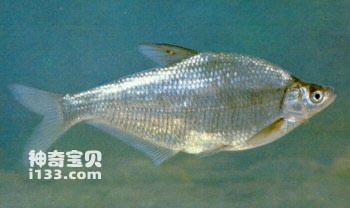Bream (Parabramis pekinensis) belongs to the order Cypriniformes, family Cyprinidae, subfamily Parabramis, and bream genus. Commonly known as: bream, Changchun bream, grass bream, oil bream, long-bodied bream; the ancient names are Chatou bream and shrink-necked bream. English name: White bream, Beijing white bream.
The body is tall, very flat on the sides, in the shape of a long rhombus, and the back of the head is bulging. The heads are small and approximately triangular; the ancients named them "bream" and "bream" based on this square and flat body shape. Li Shizhen wrote in "Compendium of Materia Medica": "Fang means Fang; bream means Bian." The mouth is small and distal; the upper jaw is slightly longer than the lower jaw, and the front edges of the upper and lower jaws are cuticle-like. No need. There is an obvious cortical ventral ridge on the ventral surface from the bottom of the chest base to the anus. The dorsal fin has strong and smooth spines, the anal fin has more rays and the base is very long. The back of the body is dark blue-grey, and other parts are silvery white; there is a wide black spot on the back of each scale, and each fin is gray-black.

It has a wide living range and can survive in still water or running water. Adult fish mostly live in the middle and lower layers of the water, and especially like to move in flowing water with large rocks on the river bed; juvenile fish like to live in shallow water and slow currents. Bream is a herbivorous fish. Its main food is aquatic plants, diatoms, filamentous algae, etc. It also eats a small amount of plankton and aquatic insects. The feeding intensity changes with the seasons. Adult fish generally eat algae and zooplankton in winter and early spring, and aquatic higher plants, plant seeds, and lake bottom plant residues from April to August, followed by algae and invertebrates. Little food is eaten in winter, but food intake increases from March onwards in spring, with the greatest intensity in summer. The age of sexual maturity varies from region to region. It is 2 years old in the Yangtze River Basin and 3-4 years old in the north. The number of eggs carried by fish aged two winters is 28,000-90,000 eggs, and that of fish aged four winters is 94,000-260,000 eggs. Mature broodstock breed in places with certain flowing water from May to August, with the peak period from the end of June to the beginning of July. In winter, they swarm in deep water of rivers or lakes and overwinter. The growth rate is slow and steady. The largest individual can reach 2 kg.
It is widely distributed in rivers and lakes in major water systems across the country. It has a large yield and is one of the main fishing targets in natural water bodies. The meat is delicious, tender and has high fat content, and the internal organs have greater fat content. It is best eaten steamed, so it is very popular among people. Each 100 grams of edible portion contains 21.0 mg of protein, 6.9-8.0 g of fat, 92 kcal of calories, 120 mg of calcium, 165 mg of phosphorus, and 1.1 mg of iron. The bream in Xiangyang, Hubei Province has been famous as early as the Northern and Southern Dynasties. It is said that Zhang Jing'er, the governor of Xiangyang at that time, specially built a "land boat" in order to favor Emperor Qi Gao, carrying 1,600 breams to pay tribute to Jianye in Kyoto. For this reason, Emperor Qi Gao granted Zhang Jing'er the title of "Chatou Governor" based on the local name of bream "Chatou bream". "Hubei Tongzhi" records: "Bream, that is, bream, is produced everywhere. The most popular ones are from Fankou in Wuchang and Lumen in Xiangyang." Bream is a delicacy all year round, so the folk custom is "catfish in spring and carp in summer." "bream" theory.
Bream is a widespread species, distributed in Heilongjiang, Yalu River, Liaohe River, Yellow River, Huaihe River, Yangtze River, Qiantang River, Minjiang River, Hainan Island and Pearl River water systems. It is found in North Korea and Russia abroad.
animal tags:
We created this article in conjunction with AI technology, then made sure it was fact-checked and edited by a Animals Top editor.